
Brigadier General Austin Conner Shofner was a United States Marine Corps officer who was captured during the Battle of Corregidor and then part of the only successful escape from a Japanese prisoner of war camp. He joined the Philippine resistance, and later returned to command units of the Marine Corps in the battles of Peleliu and Okinawa.
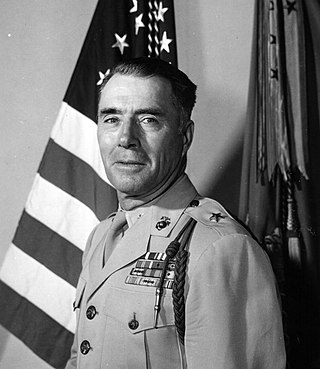
William John Whaling was a highly decorated Major general in the United States Marine Corps and an expert in jungle warfare during the Pacific War. He also competed as a sport shooter in the 1924 Summer Olympics, where he finished in 12th place in the 25 m rapid fire pistol competition.
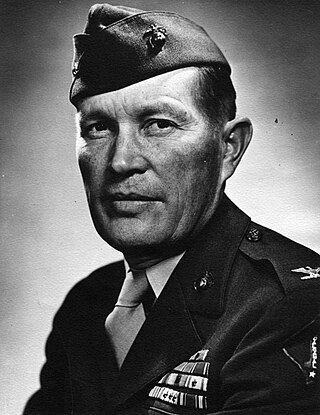
William Hartwell Harrison was a decorated officer of United States Marine Corps with the rank of brigadier general. He is most noted as commanding officer of 11th Marine Regiment during Battle of Peleliu in September 1944. Harrison later commanded the Automotive Section within Service Command, Fleet Marine Force Pacific.

Clarence Rodney Wallace was a decorated officer of the United States Marine Corps with the rank of brigadier general. He is most noted for his service as commanding officer of the 8th Marine Regiment during World War II.

August Larson was a highly decorated officer of the United States Marine Corps with the rank of major general, who is most noted for his service as commanding officer of 22nd Marine Regiment during the Battle of Okinawa and later as director of personnel at Headquarters Marine Corps.

Leonard Baker Cresswell was a highly decorated officer of the United States Marine Corps with the rank of major general. He is most noted for his service as commanding officer of 1st Battalion, 1st Marines during Guadalcanal Campaign. Cresswell later served as commanding general of Troop Training Unit, Atlantic Fleet and completed his career as Director of the Staff of the Inter-American Defense Board.

William Wallace Stickney was an American lawyer, SEC official and decorated officer of the United States Marine Corps with the rank of major general. He spent most of his Marine career as reserve officer, but was recalled to active duty during World War II and subsequently remained on active service as director of Marine Corps Reserve.
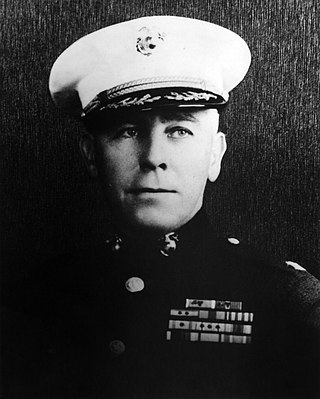
Richard Potts Ross Jr. was a highly decorated officer of the United States Marine Corps with the rank of brigadier general. He is most noted for his service with the 1st Marine Division during the Battle of Okinawa and later during the Occupation of North China.

Edward Hanna Forney was a highly decorated officer of the United States Marine Corps with the rank of brigadier general. He is most noted for his part during the Hungnam evacuation during the Korean War, the largest U.S. amphibious evacuation of civilians, under combat conditions, in American history.
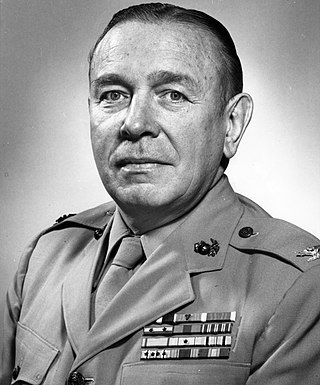
John Ralph Lanigan was a highly decorated officer of the United States Marine Corps with the rank of brigadier general. He is most noted as commanding officer of 25th Marine Regiment during Battle of Iwo Jima. Lanigan was a recipient of the Navy Cross, the United States military's second-highest decoration awarded for valor in combat.
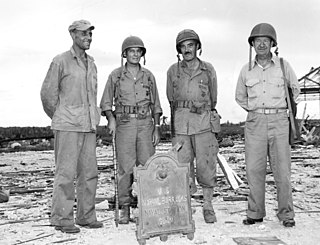
Merlin Frederick Schneider was a highly decorated officer in the United States Marine Corps with the rank of brigadier general. He is most noted as commanding officer of 22nd Marine Regiment during the Recapture of Guam in July 1944, for which he received the Navy Cross, the United States military's second-highest decoration awarded for valor in combat.

Edward Hunter Hurst was a highly decorated officer of the United States Marine Corps with the rank of brigadier general. He is the recipient of the Navy Cross, the United States military's second-highest decoration awarded for valor in combat. He completed his career as director of Marine Corps Landing Force Development Center Quantico in 1968.

Herman Poggemeyer Jr. was a decorated officer in the United States Marine Corps with the rank of major general. A veteran of three wars, he was severely wounded during the Recapture of Guam in July 1944. Poggemeyer later distinguished himself during Korean War and Vietnam and reached the general's rank in early 1970s. He completed his career as commanding general, Marine Corps Base Camp Lejeune.

Arthur Howard Butler was a highly decorated officer in the United States Marine Corps with the rank of major general. A veteran of World War II, he distinguished himself as commanding officer, 21st Marine Regiment during the Recapture of Guam in July 1944 and was decorated with the Navy Cross, one of the United States military's second-highest decorations awarded for valor in combat.

Robert Burneston Luckey was a decorated officer in the United States Marine Corps with the rank of lieutenant general. A veteran of several wars, Luckey completed his career as commanding general, Fleet Marine Force, Atlantic.
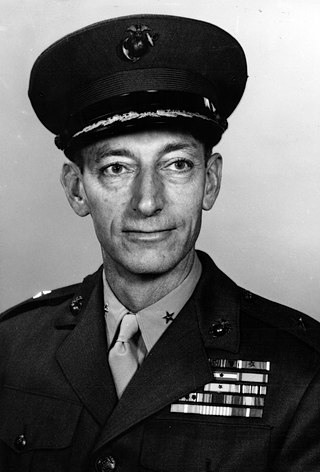
John Carroll Miller Jr. was a decorated officer in the United States Marine Corps with the rank of Brigadier general. A veteran of the Pacific War, he was wounded twice and received decorations for valor on Saipan and Okinawa. He remained in the Marines and retired as Brigadier general and Commanding general, Landing Force Training Command, Atlantic.

Kenneth Wachter Benner was a decorated officer in the United States Marine Corps with the rank of Brigadier general. A graduate of the United States Naval Academy, he trained as Anti-Aircraft Artillery officer and participated in the Defense of Pearl Harbor, Guadalcanal Campaign and Battle of Okinawa.
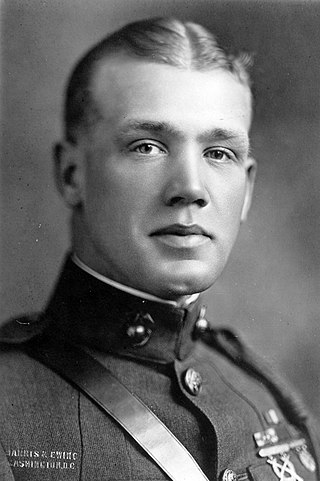
Harold Cyrus Roberts was a highly decorated officer in the United States Marine Corps with the rank of colonel. He was the recipient of three Navy Crosses, the United States military's second-highest decoration awarded for valor in combat.

Archie Edward O'Neil was an officer in the United States Marine Corps with the rank of Brigadier general. He is most noted for his service as Commanding officer, 9th Defense Battalion during the Recapture of Guam in July 1944.

Frank Edmund Garretson was an American military officer who served in the United States Marine Corps with the rank of brigadier general. A veteran of World War II, he distinguished himself as commanding officer of Company F, 2nd Battalion, 24th Marines, 4th Marine Division during the attack on Namur Island, Kwajalein Atoll, on February 1–2, 1944 and received the Navy Cross, the United States' second-highest decoration awarded for valor in combat.






















